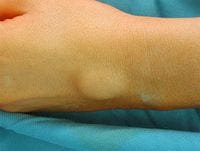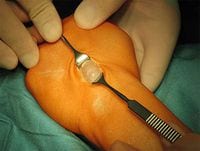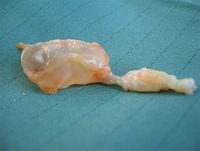GANGLION CYSTS
DEFINITION:
A ganglion cyst, or synovial cyst, is a benign soft tissue tumor that is usually both visible and palpable beneath the skin. It consists of a lump filled with a clear thick fluid and is often found at the wrist joint or one of the numerous tendon sheaths around the wrist. In 60–70% of cases, ganglion cysts occur on the extensor side of the wrist, and more rarely on the flexion side (here often in close correlation with the radial artery) or at the proximal, middle, or terminal phalanxes of the finger.
Women are three times more commonly affected than men and the peak age is between 20 and 30 years old.
The precise mechanisms that lead to the development of a ganglion cyst are not entirely clear to date. However, the following factors seem to play a key role:
- capsular system weakness (either congenitally or as the result of an injury, e.g. falling onto the hand)
- frequent overexertion
- chronic irritation of the wrist.
SYMPTOMS:

The symptoms of a ganglion cyst can range from having absolutely no symptoms, to mild tenderness, to severe pain (in some cases radiating into the elbow and fingers). If the ganglion cyst presses on a nerve, a feeling of numbness or "pins and needles" can occur in the fingers. Depending on the size of the ganglion, the patient can experience restricted movement. Growth of the cyst often depends on exertion, with the ganglion growing larger with more intense strain.
DIAGNOSIS:
A clear diagnosis can often be made based on a clinical examination and the symptoms described by the patient. A firm tumor in the area around the wrist or tendon sheath can be palpated by the doctor. Microganglions can be detected using an ultrasound or MRI. In some cases, an X-ray of the wrist must be taken in order to rule out arthritis.
TREATMENT:

Fifty percent of all ganglion cysts recede temporarily or even permanently without any treatment at all. As ganglions do not damage tendons or nerves, it is only necessary to treat ganglions that cause pain or symptoms such as restricted movement.
Previous treatments involved attempts to pop the ganglion using pressure. This led to the name "Bible cyst" as, in the past, a thick family bible was slammed on the cyst, often causing it to burst. However, as ganglions treated this way frequently reoccurred and the method is very painful, this type of method is very rarely used today.
Some doctors carry out what is known as "needling", a method in which the ganglion is punctured multiple times with a needle and then injected with anti-inflammatory medication (cortisone). This, however, only leads to permanent healing of the ganglion in about 40% of cases.

If a ganglion cyst is causing severe symptoms or if movement is restricted, it should be surgically removed. In this procedure, a small incision is made through which the cyst can be dissected and removed. In doing so, it is important to also remove the stalk attaching it to the joint or tendon to help prevent recurrance. After the operation, the wrist should be carefully mobilized as early as possible to prevent adhesion.
Unfortunately, not even the operation will always lead to guaranteed healing. Depending on the operation method, the recurrence rate is still around 5-10%.
More questions?
Our experts are happy to help you
Just give us a call!




